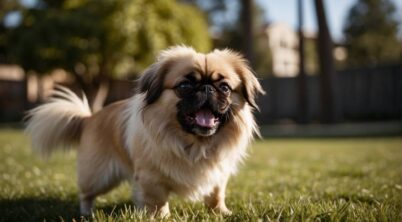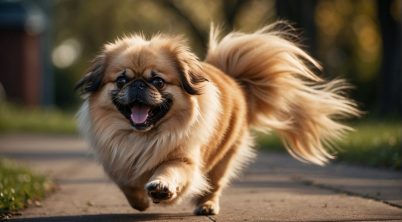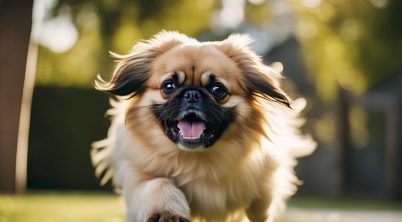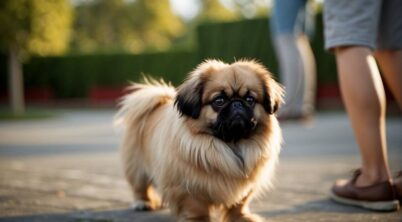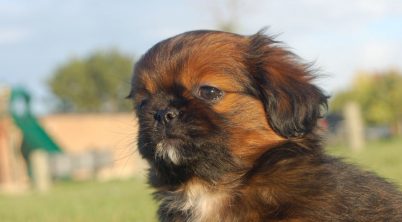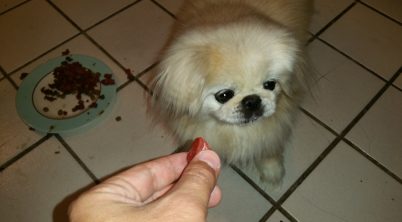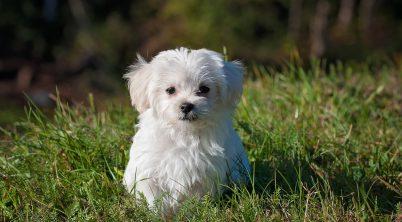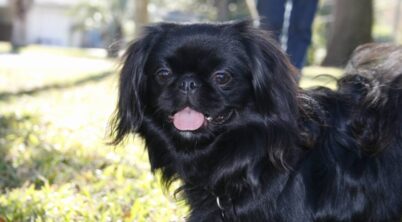The Pekingese, a dog of regal bearing and ancient lineage, boasts a long history of companionship with royalty in China. Originating in the imperial courts, these small yet dignified canines were revered as symbols of wealth and status, often found nestled in the lavish quarters of Chinese emperors and their kin. Their compact size belies a courageous and self-assured temperament, traits greatly valued and cultivated throughout their storied past.
Characterized by their distinctive flat faces, lion-like mane, and a waddling gait, the Pekingese presents an air of confidence and self-importance that commands attention. Despite their sturdy and bold demeanor, Pekingese are affectionate-hearted companions who form strong bonds with their owners. They are known to be particularly fond of attention, and their loyalty to their families is a testament to the depths of their devotion.
While the Pekingese enjoys the comforts of a sedentary lap dog life, they also exhibit an independent streak and a spirited personality. Their alert nature and tendency to bark in response to unfamiliar sounds make them surprisingly effective as watchdogs. Grooming is an essential aspect of caring for a Pekingese, as their luxurious coat requires regular maintenance to keep them in prime condition—a task once performed by the servants of royals, and now a responsibility for dedicated modern-day owners.
Pekingese Disposition
The Pekingese breed is known for its loyalty and affection towards its family. They exhibit a mix of regal dignity and a strong sense of self-importance. However, despite their small stature, they often carry themselves with a bold and courageous demeanor. Here are some key traits related to the disposition of the Pekingese:
- Independence: Pekingese dogs have an independent streak which sometimes gets mistaken for aloofness. They are not overly clingy and can enjoy time alone, but still appreciate companionship.
- Alertness: With a vigilant nature, they make good watchdogs as they are quick to alert their owners of unfamiliar occurrences. Their bark is a common indicator of their alertness to their surroundings.
- Social Interaction:
- Adults and Older Children: They generally interact well, especially with proper socialization.
- Strangers: They can be reserved, taking time to warm up to new people.
- Other Animals: They may be amicable with other pets if introduced calmly and early on in their lives.
- Affection Level: They thrive on attention and enjoy being lap dogs. This breed often displays its love and affection through close contact.
- Grooming Needs: Pekingese require regular grooming, especially if kept in a full coat, due to their long, flowing hair. Regular grooming is also a good opportunity for bonding.
The Pekingese’s disposition reflects the breed’s history as favored companions of the Chinese imperial court. Even in modern times, they carry the air of a noble lineage, requiring respect and careful management to foster a well-balanced temperament.
Breed Overview
The Pekingese is a toy breed that exudes royal dignity with its lion-like mane and unique rolling gait. This breed overview will touch upon the distinct physical features, temperament and personality traits, health considerations, and the rich history of the Pekingese breed.
Physical Characteristics
- Size: Toy breed
- Weight: Up to 14 pounds
- Height: 6-9 inches
The Pekingese sports a thick double coat, which comes in a variety of colors including black, white, cream, fawn, and black and tan. Recognizable by its flat face or brachycephalic nature, this breed showcases a lion-like mane that frames its face.
Temperament and Personality
The Pekingese is known for being deeply loyal to their family members, showing them much affection and devotion. They typically carry themselves with courage and dignity. The breed can exhibit aloof and independent tendencies but remains sensitive and polite, often preferring a quiet environment.
Health and Lifespan
- Common Health Issues: Brachycephalic syndrome, obesity, breathing difficulties, heatstroke
- Lifespan: On average 12-15 years
Regular veterinary check-ups are important as Pekingese can be prone to certain health issues related to their brachycephalic nature. Obesity is also a concern that should be monitored to prevent added stress on their bodies.
Breed History
Originating from ancient China, the Pekingese was a breed held in high esteem by Chinese royalty. Often referred to as “lion dogs” or “sleeve dogs,” the Pekingese holds a storied past intertwined with Chinese nobility and tradition.
Grooming and Care
Caring for a Pekingese involves a dedicated grooming routine due to their long, luxurious coats, as well as attention to their unique dietary and health needs. Exercise should be moderate, catering to their energy levels, and a conscious effort is required to avoid common breed-related health issues.
Grooming Needs
The Pekingese has a significant grooming requirement due to its double coat, which consists of a thick undercoat and long, coarse outer coat that can easily mat if not regularly cared for. Daily brushing is essential to prevent tangles and mats, especially behind the ears, under the armpits, and on the chest where the fur is most profuse. Beyond brushing, routine trimming around the dog’s bottom and paw pads can prevent hygiene issues. Regularly scheduled baths every few weeks, along with ear cleaning and nail trims, will keep a Pekingese looking and feeling their best.
Exercise Requirements
Pekingeses possess moderate energy levels. They require daily exercise to maintain their health and prevent obesity, but due to their compact size, they don’t need vast spaces or intensive workouts. A couple of short walks a day coupled with play sessions are sufficient. It’s important to be aware of their brachycephalic syndrome, which can make breathing difficult; thus, exercise should not be too strenuous, especially in hot or humid weather to avoid heatstroke.
Living Conditions
Pekingeses are well-suited for apartment living as they do not require a large yard to roam. They generally adapt well to indoor living and can thrive in an apartment setting. Their loyal nature makes them excellent companions for individuals or families, though their interactions with older children should be supervised to ensure gentle play. Due to their heavy coats, they can be sensitive to heat, so living conditions should remain cool to help them maintain a comfortable body temperature.
Nutrition and Diet
A Pekingese’s diet should be carefully considered to maintain optimal health. A well-balanced diet that is suitable for their particular lifestyle, age, and health status is important. Overfeeding should be avoided to prevent obesity, which can exacerbate health issues unique to the breed such as heart problems and joint issues. Feeding advice from veterinarians or professional breeders can provide guidelines for specific nutritional needs, portion sizes, and appropriate feeding schedules.
Health Management
Pekingeses are prone to certain health problems including respiratory issues due to their short noses, as well as eye concerns because of their prominent eyes. Regular health check-ups are important. It is also essential for potential and current owners to be aware of signs related to breathing difficulties such as snoring, snorting, or snuffling. Responsible breeding practices are crucial in reducing the occurrence of genetic disorders in the breed. Owners should be ready to address and prevent common health issues, ensuring a long and happy life for their Pekingese.
Training and Behavior
Pekingese dogs possess a distinctive personality that merits a thoughtful approach to training and behavior management. They are intelligent yet can exhibit stubbornness, making consistent training efforts and early socialization crucial for a well-behaved pet.
Obedience and Training
The Pekingese may not be the easiest dog to train due to stubborn tendencies. They require a patient trainer who employs positive reinforcement techniques. Short, engaging training sessions work best for maintaining their attention. Owners should establish themselves as the leader in the relationship to guide the Pekingese into desired behaviors.
- Techniques to use:
- Consistent commands
- Reward-based incentives
- Short training periods
Socialization
Proper socialization is key for the Pekingese, starting at a young age. They should be exposed to various people, pets, and environments to develop a well-rounded temperament. A well-socialized Pekingese is more likely to be outgoing and less prone to behavioral issues like excessive barking or wariness around strangers.
- Essential Socialization Practices:
- Introduction to different people and settings
- Positive experiences with other animals
- Early and frequent exposure to various stimuli
Behavioral Issues
Pekingese can develop several behavioral problems if not properly trained and socialized. These can include barking, pawing for attention, and resistance to housebreaking. Addressing these issues promptly with consistent training tactics is necessary for nurturing an agreeable family pet.
- Common Challenges:
- Excessive vocalization
- Assertive pawing or nipping
- Difficulty with housebreaking
By understanding the unique aspects of Pekingese behavior, owners can implement effective training strategies that cater to their dog’s personality and needs, resulting in a better-behaved companion.
Choosing a Pekingese
When selecting a Pekingese, prospective owners should be aware of the breed’s royal heritage, distinctive personality, and grooming needs. Ensuring a good fit with one’s lifestyle and family is crucial for a harmonious companionship.
Finding a Breeder
When looking for a Pekingese breeder, it’s essential to find someone reputable, who prioritizes the health and temperament of their Pekingese puppies. Reputable breeders will provide proof of health screenings and pedigree information to ensure the genetic health of the puppies. Prospective Pekingese owners should:
- Ask for references and follow up with them.
- Ensure the breeder conducts health tests and offers health guarantees.
- Visit the breeder’s premises when possible to see the conditions in which the puppies are raised.
Preparing for Adoption
Before adopting a Pekingese, future owners should prepare their home for a new member. Pekingese are toy breeds and can fit well into various settings, but their long, thick coat requires regular grooming. To prepare, one should:
- Create a safe space: Set up a comfortable area for the dog to relax and feel secure.
- Grooming supplies: Acquire the necessary tools such as a brush, comb, and shampoo for coat maintenance.
- Veterinarian: Establish a relationship with a vet for ongoing health management.
Compatibility with Families
Pekingese can be excellent family companions under the right circumstances. They typically bond closely with their family members, offering loyal companionship. However, due to their small size and sometimes assertive personality, they might be better suited for families with older children who understand how to interact gently with small dogs. Key points to consider include:
- Interaction with children: Teach children how to approach and treat the Pekingese with respect.
- Activity level: Ensure the family’s lifestyle can accommodate the Pekingese’s need for moderate exercise and daily interaction.
- Other pets: Pekingese may do well with other pets if introduced properly and at a young age.
Life with a Pekingese
Living with a Pekingese means embracing a lifestyle marked by the breed’s royal heritage and deep-seated loyalty. They can adapt well to various living situations and typically forge a strong bond with their owners, serving as devoted companions.
Daily Routines
A Pekingese’s day often involves a good balance of rest and activity. Morning routines should include a brief walk and some gentle play to accommodate their moderate energy levels. Evening routines could be similar, allowing the Pekingese to wind down. Consistent feeding times, grooming, and cuddle sessions contribute to a stable environment that suits the Pekingese’s preference for predictability.
Exercise and Activities
Although they’re not high-energy dogs, Pekingeses still require daily exercise to maintain their health. Short walks and indoor play cater to their activity needs, and such moderate exercise helps prevent obesity, a common health concern. Activities should include:
- Outdoor Play: Brief yet regular sessions in a fenced yard or on a leash.
- Games: Interactive games that involve toys can provide mental stimulation.
Training Milestones
When training a Pekingese, patience is key. They often become deeply attached to one person, which encourages training through positive reinforcement. During the puppy stages, focus on basic commands and socialization. As an adult dog, reinforce these lessons and introduce more complex obedience training. They might display an independent streak, but consistent training can yield good results.
Health Care
Due to their distinctive facial structure, Pekingese are prone to brachycephalic syndrome, which must be monitored. Veterinary care is essential in catching and managing any breed-specific issues early on. A Pekingese’s health maintenance routine includes regular check-ups, vaccinations, and addressing any signs of common ailments like respiratory difficulties.
Routines involving health and companionship intertwine day-to-day, ensuring the Pekingese lives a content and well-maintained life as a treasured family pet.

